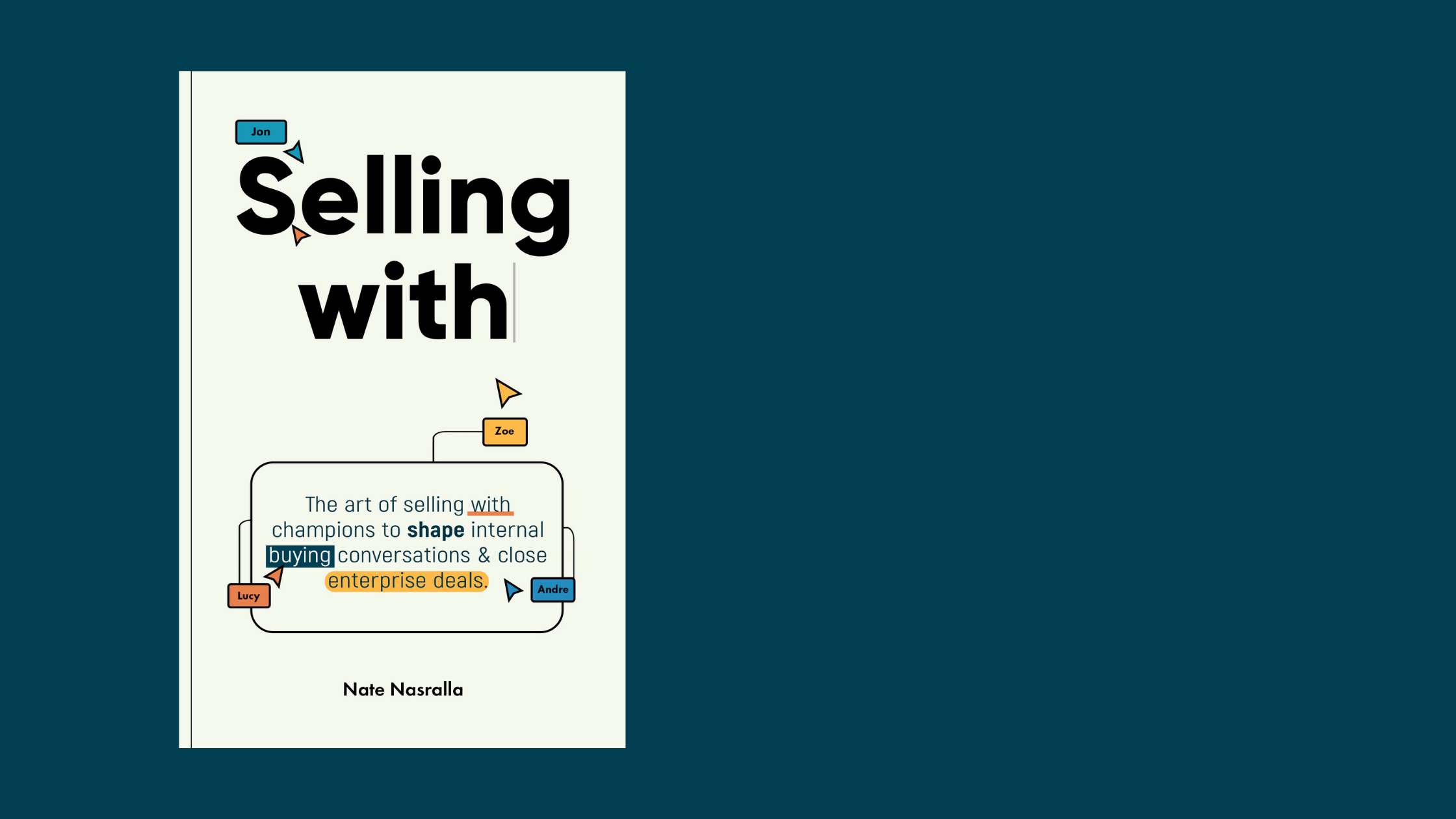How to Sell Priorities, Not Just Problems + 5 Steps to Shift Your Messaging


We live in an Attention Economy.
Which means budget flows where your buyers’ attention goes.
It also means your competition is the noisy, overwhelming, distracting reality that is "life" right now.
So at times, a competitor will steal your deal. But more often than not, you'll lose deals because they slip down the priority list.
(The people you need to care, don’t. They don’t have the time.)
They do have a ‘heckuva lot to oversee, which is why they keep such a tight filter on what they do and don’t pay attention to.
Reid Hoffman calls this “choosing which fires to let burn.” He says in Blitzscaling:
Most of us are willing to fight fires; it’s a smaller subset of people who are capable of noting the presence of a roaring blaze that might soon cut off all escape routes without allowing it to distract them from their laser-focused effort to fight a more urgent fire.
Selling to Priorities, Not Problems
Did you catch that? Putting out a fire isn’t enough.
Solving a genuine problem with real costs isn’t enough to grab attention.
So I think it’s fair to define things this way:
- Priorities (plural) are mental filters. The brain’s equivalent to email spam filters.
- A priority (singular) is something specific that executives are already sold on, and actively subordinating other important topics to.
We can plot the relationship between attention (priorities) and win rates like this, including the Priority Filter:

Notice how win rates only increase after you rise above the noise by selling to a priority.
A few notes for you on this:
1/ Your deal can be 1 of 3 things to your buyer.
You'll either be:
- The meeting.
- In the meeting.
- After the meeting.
In that order. Here’s how to classify each one:
- “The Meeting.”
You’re the priority. You’re addressing a fire that’s burning so hot, you’re the full meeting agenda. You’ve captured enough mindshare that the buying committee spends all their time on the project you'll enable.
But if you ask to setup an exec-level meeting and get denied (assuming you meet the Three T’s of Multithreading), then you’re not selling to a leadership priority.
Dedicated meetings on this topic aren’t already happening internally. See below.
- “In the Meeting.”
Here, you’ve made it past the Priority Filter, and landed as a line item on an internal meeting agenda. You’re solving a costly problem for a smaller set of contacts — just not the company at large.
(This is where most closed-won deals fall, by the way.)
- “After the Meeting.”
When you ask for an update and hear, “Oh sorry, we ran out of time last meeting, I’m hoping we’ll get to it next week,” then your deal is a thought raised in passing.
This last one is where the majority of deals fall (most win rates hover between 17% - 20%, so you could say this bucket represents > 80% of deals).
A friend and VP of Sales, Kyle Asay, put it this way:
Reps would be terrified if they knew how many of their deals died with a 20 second conversation at the end of a 1:1 between their contact and their boss.
“Hey so I’m looking at this…”
“Not a priority right now, let’s look at it in 6 months.”
“Ok.”
This type of after-the-meeting exchange is the difference between project and product risk.
In a complex sale, the first risk is that no project is prioritized. So your product isn't even evaluated.
This is basically what happens. Something else steals all the attention like a younger sibling:

2/ Elevate the focus of your discovery questions to separate issues from true problems.
Problems are often the first focus in discovery. For good reason, too. Writing a sharp problem statement is the start of a compelling narrative.
But if you don’t “stack rank” the problem you discovered against other problems in the company — including those that are entirely unrelated to your product — you don’t know if you’ve found an issue, or a problem:
- Issues only become problems when they’re blocking a priority.
- Leaders see all other issues as distractions, not problems.
So try asking questions like this:
Which issues do you think your team would put before this one on your next meeting agenda?
I’m guessing < issue > isn’t taking up 100% of your attention. Are there are topics you find you and the team spending more time on?
This sounds frustrating, for sure. But I’m curious why this hasn’t already been addressed? Is there another project that’s been more the focus lately?
By the way, when you phrase your questions here, you’ll want to assume there are higher priorities. Let your prospect correct you if that’s not the case.
3/ Craft your message around internal Trigger Phrases.
When you use the shared, internal language of your buyers, it signals that you’re aligned with their priorities.
That shifts you from selling products, to enabling projects they’re already sold on.
Here’s an example that Mark Kosoglow shared as part of an inside look at Outreach’s growth.
”Ten Million or Die,” or #TMOD for short, was their internal Trigger Phrase. Shorthand for the goal everyone was sold on. Hitting $10M in ARR by a certain date.
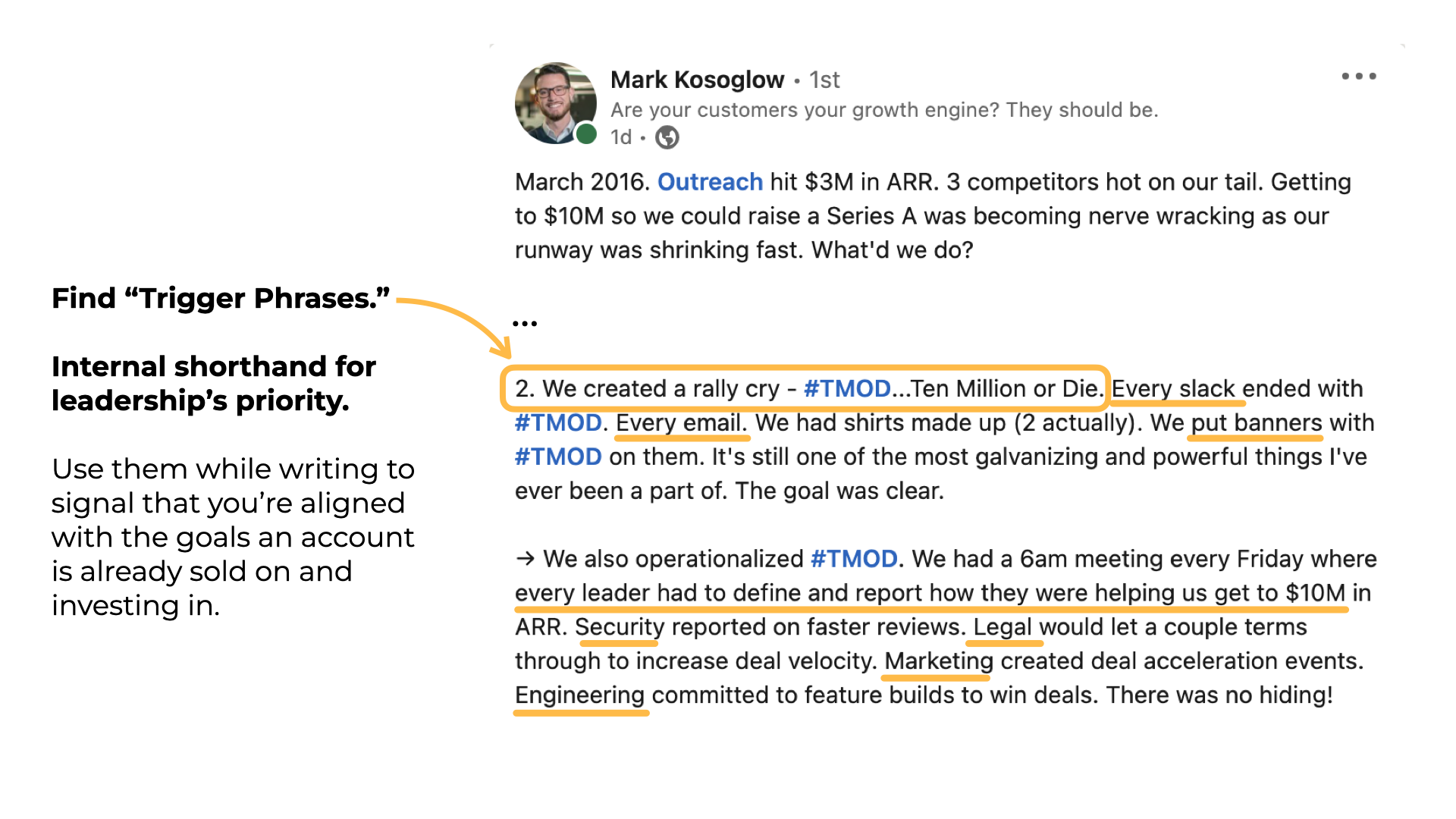
Weaving #TMOD into your message would have been your way to:
- Land the initial meeting
- Multithread early in the deal
- Stay top of mind throughout the cycle
Think about writing up a memo for Mark, the VP of Sales, to share with Manny, his CEO.
The idea is that you to make it unbelievably easy to forward your message, without forcing your champion to rewrite it, or translate your lingo into theirs.
The headline could read something like:
#TMOD: A Shortcut on Our Path to $10M
The question then, is, how do you find a Trigger Phrase?
You can ask:
“Are there any certain phrases you keep hearing your leadership team repeat over, and over again?”
Followed up with:
What’s the link between that priority, and our project?
As another example, one of our past deals was part of a project named Sundrop. (To create a “bright" future, by "lighting the path" into a new market.)
I knew we had something big when I heard that.
Because projects without a specific codename or trigger phrase are destined for irrelevance. They end up in the dark, forgotten corners of the enterprise.
So don’t go chasing ghosts.Use the customer's internal language and signal you're aligned with a project their leadership already put the spotlight 🔦
4/ Create a sharp problem statement that’s framed correctly.
The wait to get a new project approved can be unbearable. (Remember the story about the women’s washroom?)
That’s even if the request is coming from an employee, with the same email domain — let alone initiated by an external sales rep.
That’s where the process of crafting a written problem statement comes from. You need a sharp hook to follow the trigger phrase in your headline. Here’s a formula to try out:
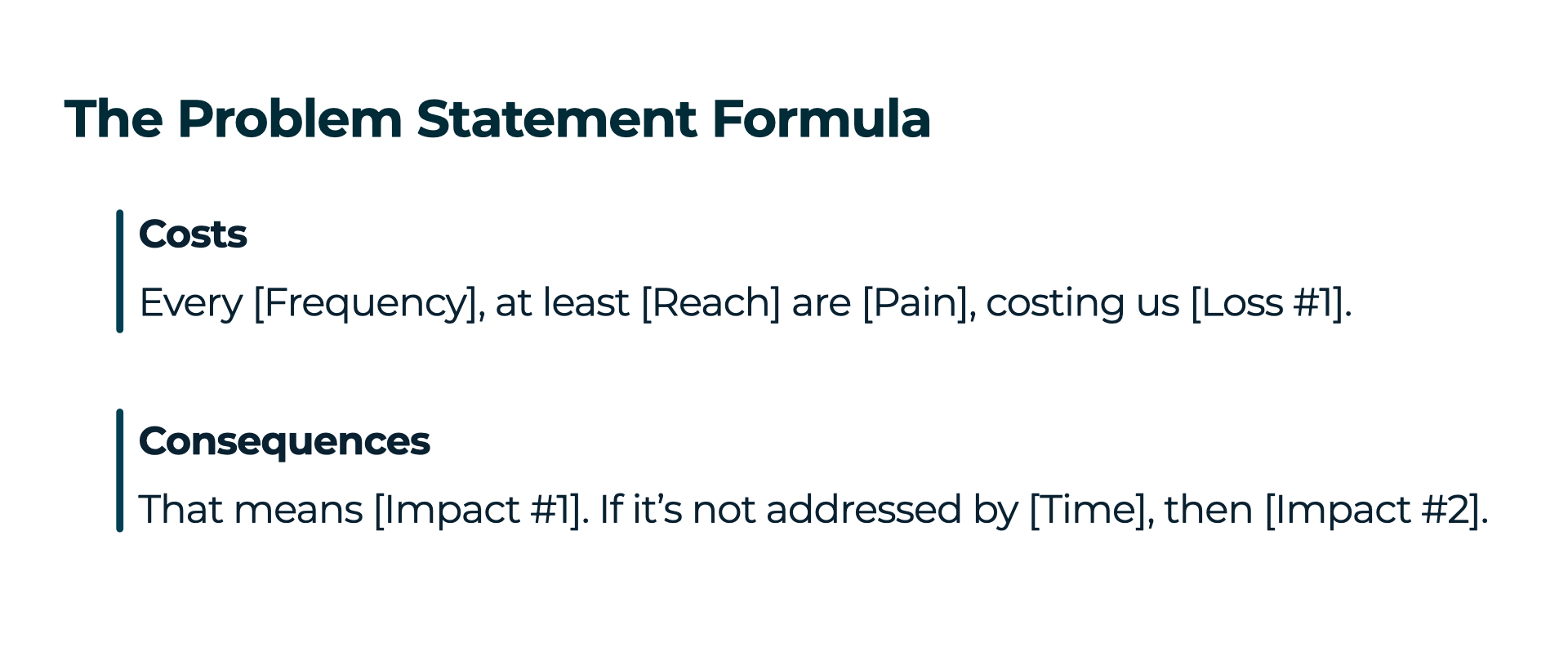
Here’s an example of how this looks, applied to Drift’s conversational marketing software:

Along with a second version you can test. This one comes in handy if you’re in a space that’s not as easy to measure:

5/ Sell the approach before selling a product.
An approach is the path you’ll take to reach a certain priority.
It’s the route highlighted on your map. How you’ll reach the goal. Not who you’ll travel with, or what brand of car you’ll be driving.
It’s more neutral than that. Because the approach is always vendor agnostic. It confirms everyone’s aligned on the higher order question of:
What must be true about how we reach this goal?
So it’s less, “use our content automation system,” and more, “shift the mix of new leads from paid to organic sources.”
Take, for example, a newly-hired CRO. Her company just raised a Series B. The CRO will ask herself, What’s my biggest revenue opportunity? Is it:
- Acquiring brand new logos?
- Boosting net revenue retention (NRR)?
Let’s say it’s boosting NRR. Investors have been talking a lot about that lately. Does she:
- Hire more account managers for the enterprise segment?
- Focus on untapped cross-sells in the small business segment?
There are lots of levers she can pull. In fact, if you look this “Driver Tree” below, you’ll notice that the higher the level contact you’re selling with, the more routes, choices, trade offs, and “approaches” there are.
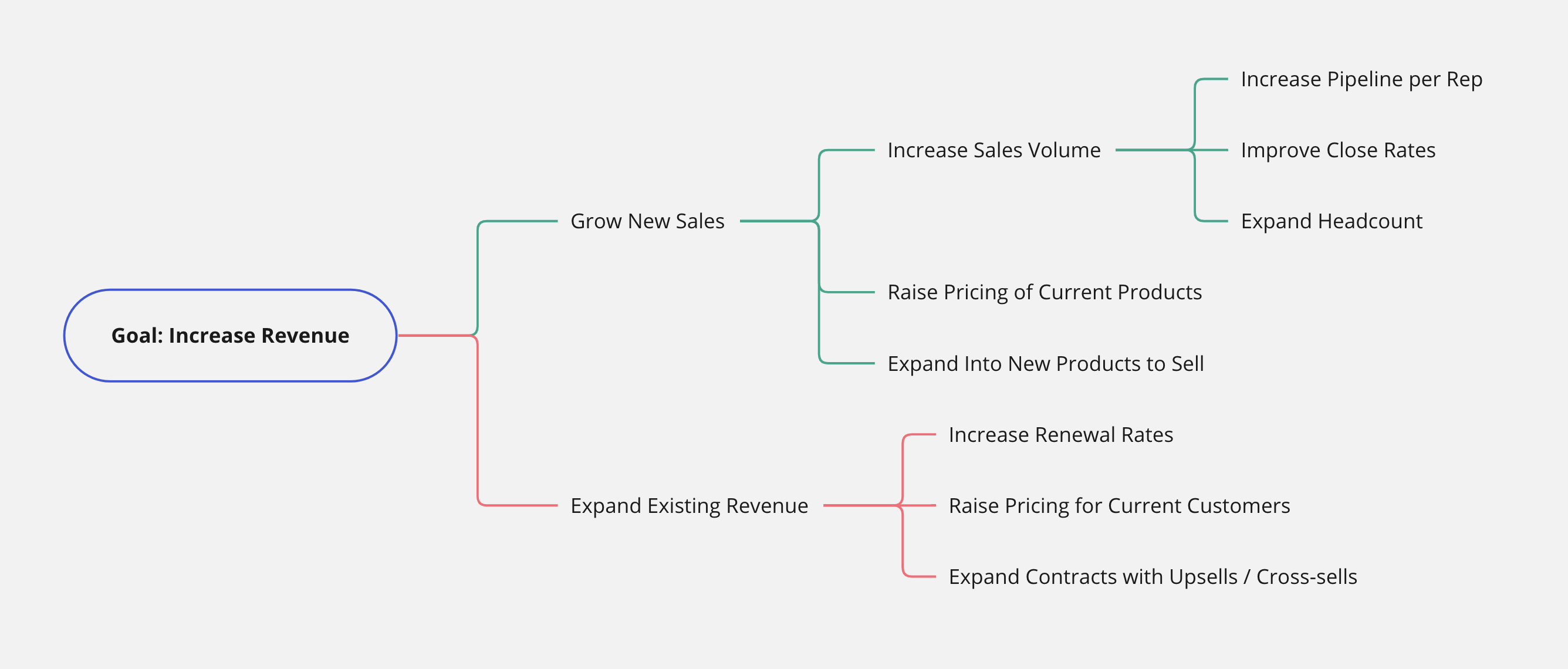
You can “drive revenue” in a lot of ways.
The CRO’s got to pick her priority — which affects buying decisions later.
Now, suppose you sell a sales intelligence platform that helps generate leads. If the CRO’s thesis is that a singular focus on NRR is best, and she’s entirely focused on expanding revenue from the customers who already love them, you have two options:
- Align your platform with her thesis.
Let’s say you can give her data on customers who recently changed jobs, and could champion her product at their new company.
- Reshape her thesis.
How long can she afford to focus on NRR, without landing more logos to eventually expand? Aren’t the seeds for NRR sown early, in the new sales and onboarding process?
In summary, any deal you’re developing that’s not aligned with a company priority is at risk.
Even if you’ve built a solid champion, it’s your job to enable them with a sharp message. To cut through cluttered inboxes, and packed meeting agendas.
FAQ's on:
Why stop now?
You’re on a roll. Keep reading related write-up’s:
Draft with one click, go from DIY, to done-with-you AI
Get an executive-ready business case in seconds, built with your buyer's words and our AI.
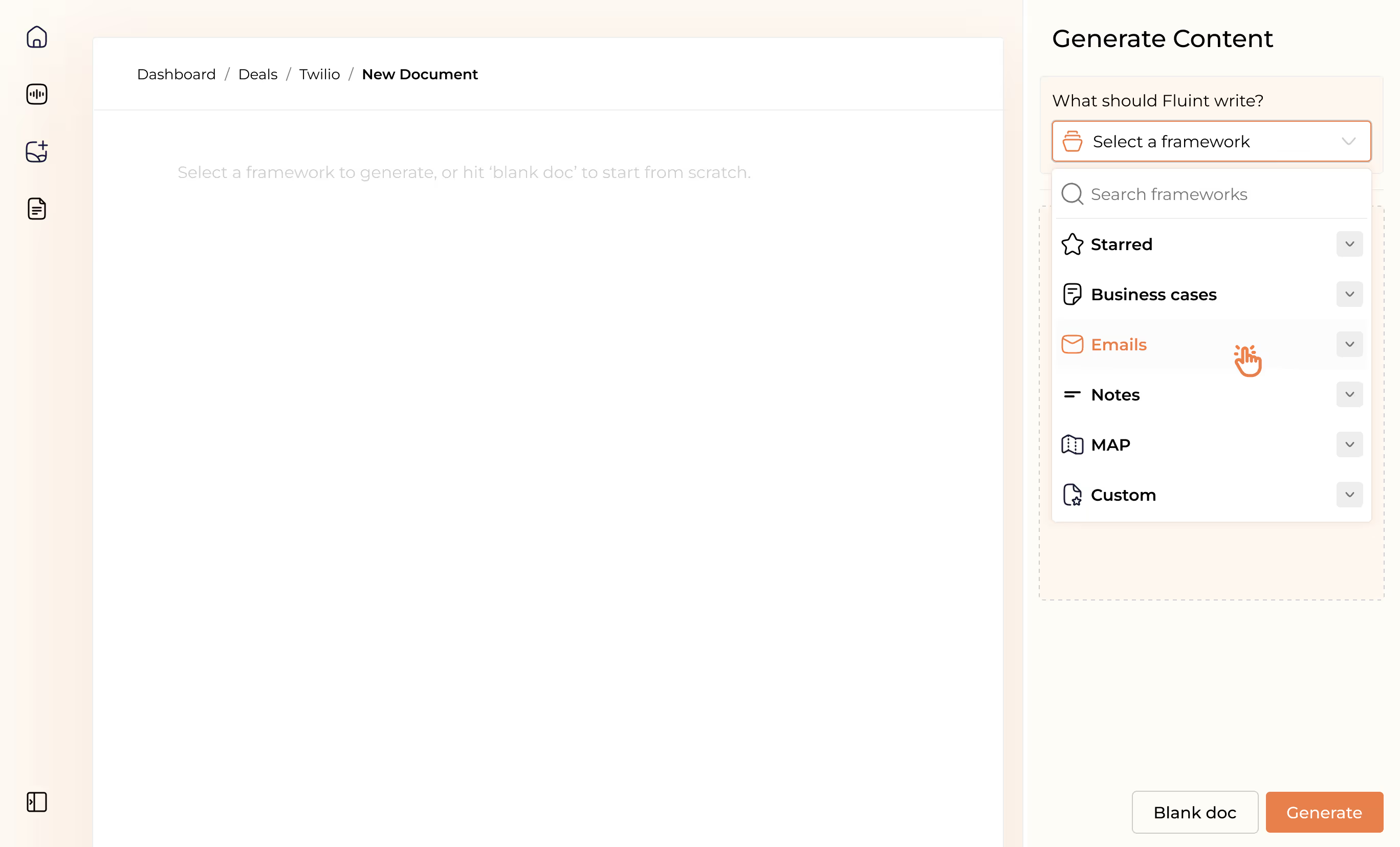
Meet the sellers simplifying complex deals
Loved by top performers from 500+ companies with over $250M in closed-won revenue, across 19,900 deals managed with Fluint

Now getting more call transcripts into the tool so I can do more of that 1-click goodness.



The buying team literally skipped entire steps in the decision process after seeing our champion lay out the value for them.


Which is what Fluint lets me do: enable my champions, by making it easy for them to sell what matters to them and impacts their role.




